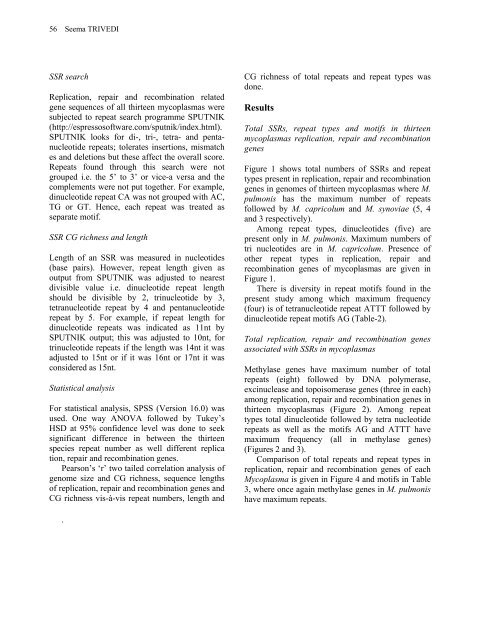Download - Journal of Cell and Molecular Biology - Haliç Üniversitesi
Download - Journal of Cell and Molecular Biology - Haliç Üniversitesi
Download - Journal of Cell and Molecular Biology - Haliç Üniversitesi
Create successful ePaper yourself
Turn your PDF publications into a flip-book with our unique Google optimized e-Paper software.
56<br />
Seema TRIVEDI<br />
SSR search<br />
Replication, repair <strong>and</strong> recombination related<br />
gene sequences <strong>of</strong> all thirteen mycoplasmas were<br />
subjected to repeat search programme SPUTNIK<br />
(http://espressos<strong>of</strong>tware.com/sputnik/index.html).<br />
SPUTNIK looks for di-, tri-, tetra- <strong>and</strong> pentanucleotide<br />
repeats; tolerates insertions, mismatch<br />
es <strong>and</strong> deletions but these affect the overall score.<br />
Repeats found through this search were not<br />
grouped i.e. the 5’ to 3’ or vice-a versa <strong>and</strong> the<br />
complements were not put together. For example,<br />
dinucleotide repeat CA was not grouped with AC,<br />
TG or GT. Hence, each repeat was treated as<br />
separate motif.<br />
SSR CG richness <strong>and</strong> length<br />
Length <strong>of</strong> an SSR was measured in nucleotides<br />
(base pairs). However, repeat length given as<br />
output from SPUTNIK was adjusted to nearest<br />
divisible value i.e. dinucleotide repeat length<br />
should be divisible by 2, trinucleotide by 3,<br />
tetranucleotide repeat by 4 <strong>and</strong> pentanucleotide<br />
repeat by 5. For example, if repeat length for<br />
dinucleotide repeats was indicated as 11nt by<br />
SPUTNIK output; this was adjusted to 10nt, for<br />
trinucleotide repeats if the length was 14nt it was<br />
adjusted to 15nt or if it was 16nt or 17nt it was<br />
considered as 15nt.<br />
Statistical analysis<br />
For statistical analysis, SPSS (Version 16.0) was<br />
used. One way ANOVA followed by Tukey’s<br />
HSD at 95% confidence level was done to seek<br />
significant difference in between the thirteen<br />
species repeat number as well different replica<br />
tion, repair <strong>and</strong> recombination genes.<br />
Pearson’s ‘r’ two tailed correlation analysis <strong>of</strong><br />
genome size <strong>and</strong> CG richness, sequence lengths<br />
<strong>of</strong> replication, repair <strong>and</strong> recombination genes <strong>and</strong><br />
CG richness vis-à-vis repeat numbers, length <strong>and</strong><br />
.<br />
CG richness <strong>of</strong> total repeats <strong>and</strong> repeat types was<br />
done.<br />
Results<br />
Total SSRs, repeat types <strong>and</strong> motifs in thirteen<br />
mycoplasmas replication, repair <strong>and</strong> recombination<br />
genes<br />
Figure 1 shows total numbers <strong>of</strong> SSRs <strong>and</strong> repeat<br />
types present in replication, repair <strong>and</strong> recombination<br />
genes in genomes <strong>of</strong> thirteen mycoplasmas where M.<br />
pulmonis has the maximum number <strong>of</strong> repeats<br />
followed by M. capricolum <strong>and</strong> M. synoviae (5, 4<br />
<strong>and</strong> 3 respectively).<br />
Among repeat types, dinucleotides (five) are<br />
present only in M. pulmonis. Maximum numbers <strong>of</strong><br />
tri nucleotides are in M. capricolum. Presence <strong>of</strong><br />
other repeat types in replication, repair <strong>and</strong><br />
recombination genes <strong>of</strong> mycoplasmas are given in<br />
Figure 1.<br />
There is diversity in repeat motifs found in the<br />
present study among which maximum frequency<br />
(four) is <strong>of</strong> tetranucleotide repeat ATTT followed by<br />
dinucleotide repeat motifs AG (Table-2).<br />
Total replication, repair <strong>and</strong> recombination genes<br />
associated with SSRs in mycoplasmas<br />
Methylase genes have maximum number <strong>of</strong> total<br />
repeats (eight) followed by DNA polymerase,<br />
excinuclease <strong>and</strong> topoisomerase genes (three in each)<br />
among replication, repair <strong>and</strong> recombination genes in<br />
thirteen mycoplasmas (Figure 2). Among repeat<br />
types total dinucleotide followed by tetra nucleotide<br />
repeats as well as the motifs AG <strong>and</strong> ATTT have<br />
maximum frequency (all in methylase genes)<br />
(Figures 2 <strong>and</strong> 3).<br />
Comparison <strong>of</strong> total repeats <strong>and</strong> repeat types in<br />
replication, repair <strong>and</strong> recombination genes <strong>of</strong> each<br />
Mycoplasma is given in Figure 4 <strong>and</strong> motifs in Table<br />
3, where once again methylase genes in M. pulmonis<br />
have maximum repeats.

















